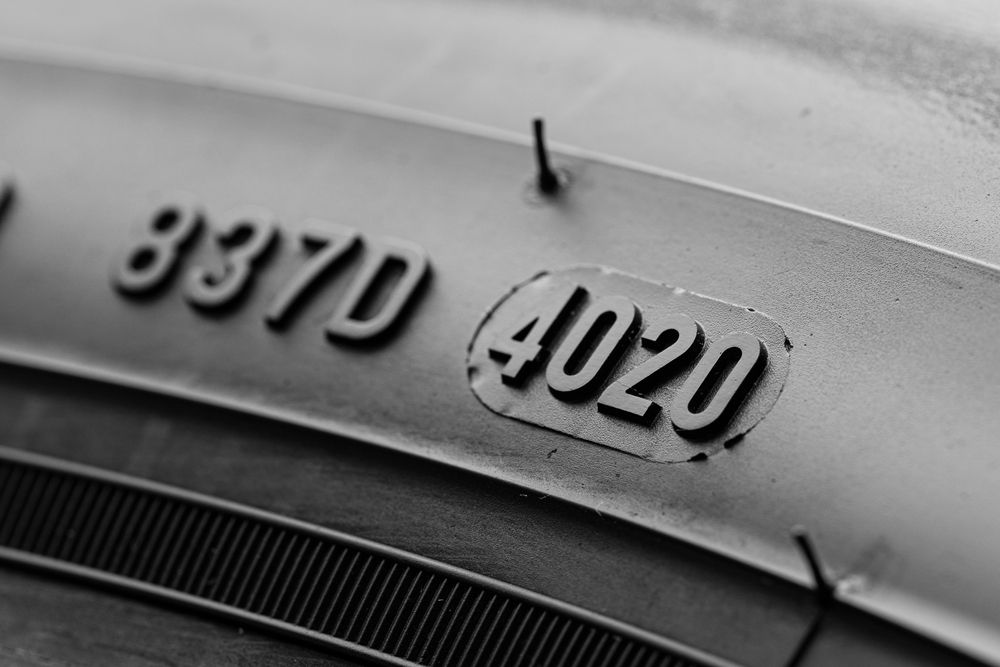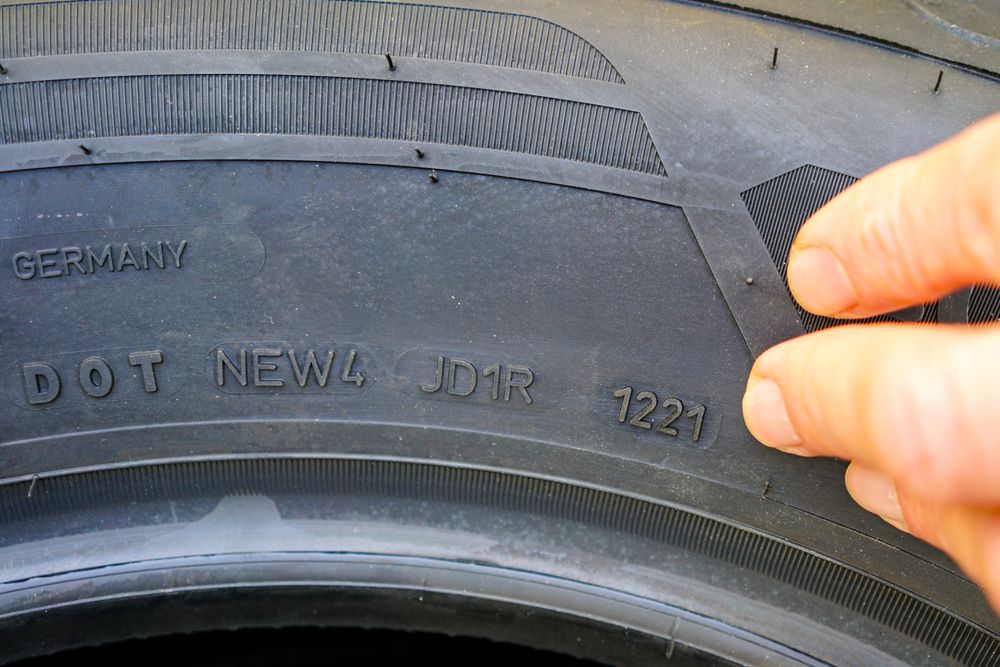Tire age is a highly-debated topic in the car community, with many
wondering whether they should buy new or used tires for their vehicle.
When you buy new tires, they should be at most 18 months old. It is best to
buy tires less than one-year-old to experience as few issues as possible.
Tires naturally break down as they age, regardless of whether or not they
are used. Therefore, you can get ahead of normal wear and tear by
purchasing new ones.
This article will explore why tire age is essential, how quality is
determined, and what to consider when buying new tires.
 Customer looking at the manufacturing dates of the tires.
Customer looking at the manufacturing dates of the tires.
When You Buy A New Tire, How Old Should It Be?
When you buy a new tire, it should be a year old at maximum. This is
calculated from the time it leaves the manufacturer's assembly line, not
from the day you bought it and put it on your vehicle.
However, brand-new tires may not always be accessible. In this case, as
long as they are at most 18 months, purchasing a set of tires older than
one year is a good idea. Stored tires older than 1.5 years will lead to
further expenses, as you will get less use out of them.
How To Read Tire Age Code?
The last four digits of the tire manufacturing code represent the manufacturing date. The first two digits represent the week of the year, and the last two represent the year. For example, 4020 represents the 40th week in 2020.
 4020 tire manufacturing code representing the 40th week in 2020.
4020 tire manufacturing code representing the 40th week in 2020.
Are 3-Year-Old Tires Too Old?
Three-year-old tires are not necessarily too old. The correct answer to
this question depends on how the tires have been kept up and stored. A
three-year-old tire can still be used as long as the tread is good and
there is no dry rot or punctures.
However, if a tire has been kept in storage for more than one year without
being rotated or aired up, it may not be as safe to use on your vehicle.
Therefore, you should always check the tread on your tires before buying,
and remember that tire age is determined by the manufacturing date, not the
date of purchase.
You should never use tires with less than 2/32 inches of tread depth on the
road because they don't have proper traction. These dangerous tires can
cause you to lose control and hydroplane when water gets trapped between
the tire and the road surface.
If you reside in a region with extreme weather conditions, your tires may
age more quickly and need replacement much sooner. For example, those who
live in a warmer climate may need special summer tires for safe driving
throughout the year.
Are 5-Year-Old Tires Still Good?
5-year-old tires are perfectly fine to be driven if you properly maintain
them. However, remember that the rubber is less elastic than when it was
new, and the tread will likely be worn down and smoothed out. This reduces
traction on wet and slippery surfaces.
Are 7-Year-Old Tires Still Good?
Tires that are seven years old are still good in certain conditions.
Generally, it would be best if you replaced your tires every six years past
the manufacture date at maximum. However, you can safely use them for up to
ten years if they're properly maintained and in good shape.
Older tires may become brittle over time, leaving more room for cracks. In
addition, the treads may begin to separate from the casing, presenting a
blowout risk while driving on the highway.
If the material turns hard or crumbly, there will no longer be a protective
layer between you and the road, leading to more significant traction loss
over time.
Dry rot can also affect older tires. Water and other fluids seep into the
casing through tiny holes, making it heavier than normal. This can lead to
future blowouts. In addition, tires with dry rot usually show bubbles on
their surface or peel off their outer layers.
When driving with such tires, it's wise to travel with spare tires in the
event of a breakdown. The last thing you want is to break down on the side
of the road with one tire flat or blown out.
Why Do My Brand-New Tires Look Old?
Your brand-new tires may look old because new tires are made with a
protective coating called "plasticizer," which prevents fading in the sun.
Unfortunately, as soon as you drive your car on the new tires, they start
losing this protective coating, causing them to look worn out like an older
tire.
Most people expect new tires to be bright and shiny, only to find their new
rubber looks old and faded straight out of the box. Another reason is that
tires are made from natural rubber derived from latex.
The process used to make tires takes about 30 days, and during that time,
the rubber is stressed by stretching, heating, and cutting it. All of these
processes cause the material to become less flexible than when it was first
created.
So what does this mean for you? If you buy cheap tires that aren't made of
high-quality materials, they will age quickly, regardless of whether
they're new. As a result, if you're considering purchasing a set of
inexpensive tires, be aware that they will probably start to look worn
after just a few months of use.
 1221 tire manufacturing code representing the 12th week in 2021.
1221 tire manufacturing code representing the 12th week in 2021.
How Can You Tell If New Tires Are Old?
New tires are considered old if the treads are worn down more than 50%. The
depth of the treads is measured by how flat the tread surface is relative
to how much the original depth remains. A tire worn down 50% has only half
as much rubber left on it as when it was new.
The sidewall will show signs of cracking or tearing. The tire's sidewall is
the portion that extends from top to bottom along the tire's outer border.
This area does not have tread on it like other parts of the tire, but an
outer rubber coating over some underlying steel wires gives it strength.
As a result of exposure to UV light from sunshine and other sources, this
coating ages and eventually becomes brittle.
Why Do New Car Tires Wear Out So Fast?
New car tires wear out so fast because the rubber compound used in modern
tires doesn't last as long as it used to. So instead, it's stronger, which
means it can handle more force from the road, but it also wears out faster.
It's not just the rubber; the tread pattern has changed too. Tread patterns
are designed to shed water and increase traction on wet roads but make for
more rapid wear on dry roads.
The solution is to use a tire sealant like Fix-A-Flat, which can get you up to 100 miles in case of a flat tire.
If you're going far away, take a spare tire with you just in
case something happens. The last thing you want is to be stuck in the
middle of nowhere with the need to replace your tire.
If your vehicle calls for a compact spare tire instead of a full size,
check with a local tire shop or another location that sells tires to see if
they have one available.
Conclusion
Many people underestimate the big deal of their tires' age and how long you
should use them before they need to be replaced with new ones.
When purchasing new tires, please pay special attention to the date of
manufacture (when the tire was made) and ensure they are properly inflated.
In addition, the date code, treadwear warranties, and fine print should be
major factors when buying tires.
How old new tires should be all comes down to personal preference.
Tire manufacturers typically suggest replacing them every six years, as
tires older than this can present safety issues for cars.
However, if maintained properly, they can last a few years longer without
needing to replace.
Understanding when a tire was made will help you make the right purchasing
decision. Just be sure to do your safety research before you get on the
road.